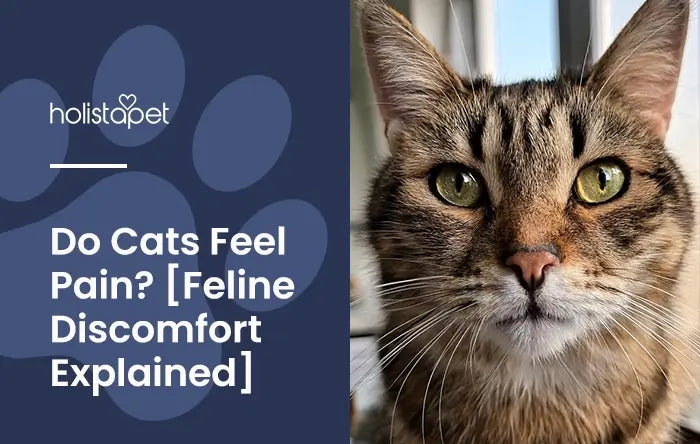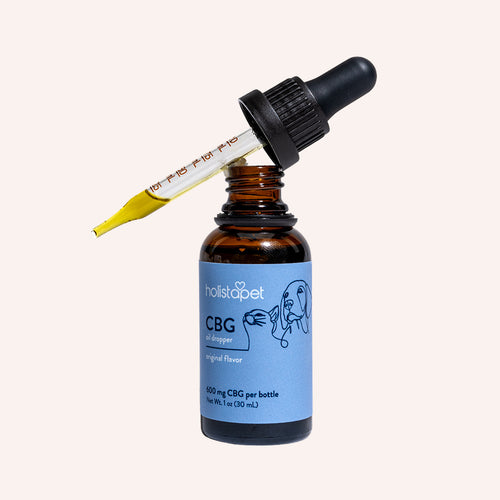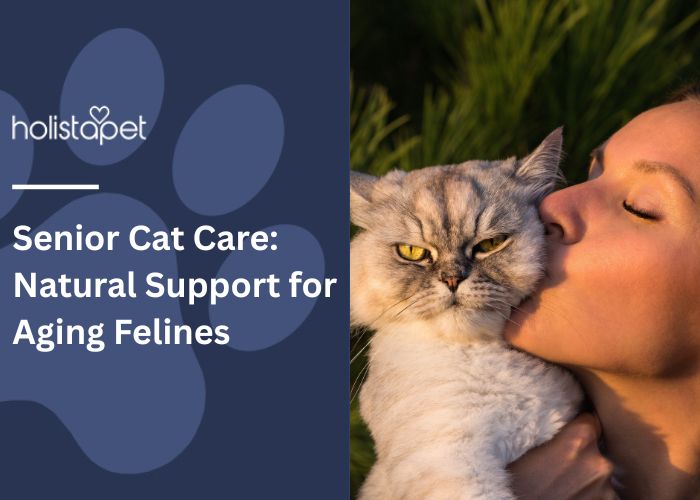The question, "Do cats feel pain?" has a simple answer: absolutely. They may not show it the same way we do, but their body still reacts when they are hurt.
An aching limb, an upset tummy, or a stiff joint can throw kitties off their routine. Owners need to be vigilant and spot these signs early to help their pets thrive day in and day out.
The Simple Answer — Yes, Cats Absolutely Feel Pain

Cats absolutely feel pain, and they experience it in many of the same ways humans do. A cat's pain may show through behavioral changes or strange postures. Their body reacts to injury, illness, or aches just as ours would. Whether it's moderate pain from a sore leg or severe soreness from an operation, cats feel it. The key is catching those subtle signs before they worsen.
Physical Pain in Cats
Cats feel physical pain in many ways. A sore leg, bowed head, or stiff posture can be a clear sign. Some felines limp or avoid climbing when their joints ache. Others hide or change litter box habits if moving feels uncomfortable. Facial expressions, dilated pupils, or a vacant look also point to aches.
Emotional and Mental Pain in Cats
Emotional pain affects cats, and it shows. They act nervously or upset. Worried or negative thoughts spark behavior changes fast. Agitation looks like pacing, restless sleep, or clingy moments.
Big shifts at home trigger distress. New pets, loud work, travel, or a lost friend can shake confidence. Affected cats may retreat, skip meals, or groom less.
Why Cats Hide Their Pain
Felines conceal their pain because their survival instincts run deep. In the wild, showing weakness could invite danger. Even house cats keep this instinct, so they mask pain with typical-looking actions. A cat may behave normally while quietly dealing with soreness.
This secret pain makes it tricky for cat parents. Subtle signs like a lowered head, abnormal posture, or behavior changes often go unnoticed. Watching closely helps catch issues early and prevent bigger problems down the line.
Survival Instincts in the Wild
Wild cats survive by hiding their weaknesses. If a predator sees discomfort or injury, the cat becomes easy prey. This survival tactic stayed with domestic cats. Even when safe at home, they still cover up signs of pain.
A cat may act fine while battling a sore leg or an aching stomach. Small changes in posture or grooming are often the only clues. Spotting these shifts helps owners protect their kitties from complications.
Differences Between Cats and Dogs
Dogs experiencing pain often cry out, limp, or seek comfort when they feel hurt. Cats, on the other hand, keep quiet and hide. This quiet nature makes spotting pain in cats much harder. A cat's subtle signs include hiding, stiffness, or refusing food. Dog owners may spot issues faster, but cat parents must look closer.
Why Hidden Pain Puts Cats at Risk
When cats hide pain, problems grow worse. An aching limb, upset stomach, or stiff joint may seem small at first, but without help, it can turn serious. Cats often mask the aches they're feeling until the severity reaches a breaking point.
Hidden pain delays treatment and affects daily life. Skipped meals, vacant looks, or stiff movements all point to trouble. Pet owners who notice these signs early can work towards their pet's comfort immediately.
Common Signs That a Cat Is in Pain

Cats rarely cry out, but their actions tell the truth. Watch for these changes that often signal issues:
- Reduced Appetite or Refusing Food. Skipping meals hints that something feels wrong.
- Hiding or Seeking Isolation. Cats may avoid people when they're hurting.
- Increased Aggression or Irritability. Sudden mood shifts can mean soreness.
- Changes in Grooming Habits. Over- or under-grooming signals irritation.
- Altered Vocalizations. Crying, growling, or odd purring show distress.
- Limping or Favoring a Leg. A sore limb changes movement.
- Avoiding Jumps or Climbing. Uneasiness makes them skip routines.
- Posture Changes and Stiffness. Arched backs or lowered heads reveal pain.
Related Post: How To Tell if a Cat Is in Pain: Warning Signs + Solutions
Types of Pain in Cats
Cats can experience different kinds of pain, each with its own cause. Knowing the type helps owners and vets decide how to respond to it best. Let's talk about:
- Acute Pain (Injuries, Surgery, Sudden Trauma)
- Chronic Pain (Arthritis, Dental Disease, Illness, Aging)
- Emotional Pain (Stress, Anxiety, Grief)
Acute Pain (Injuries, Surgery, Sudden Trauma)
Acute pain happens fast and feels sharp. Felines may show it after surgery, sudden injuries, or accidents. A cat with acute pain might limp, cry out, or avoid moving altogether. This type of pain can look intense but often fades once the cause heals. Quick vet care helps with pain management and prevents lasting issues.
Chronic Pain (Arthritis, Dental Disease, Illness, Aging)
Chronic pain builds slowly and lasts a long time. Older cats often face joint aches from arthritis or bone disease. Dental problems can also cause ongoing soreness that makes mealtimes difficult.
Cats with chronic pain may hide, move less, or sleep more. Weight loss, stiff posture, and reduced mobility are also common signs. This type of discomfort needs steady care to keep affected kitties comfortable.
Emotional Pain (Stress, Anxiety, Grief)
Cats can feel emotional pain that weighs on their daily life. Loud noises, sudden changes, or a new pet may cause agitation or worried thoughts. Loss of a companion can bring grief that shifts mood.
These feelings often appear as hiding, aggression, or restless sleep. Some cats stop eating or grooming when upset. Paying attention to these changes helps owners comfort their cats and restore a calm routine.
How Veterinarians Diagnose Pain in Cats

Vets use many tools to figure out pain in cats. Since kitties hide pain well, professionals look for changes in both body and behavior. Careful exams reveal problems that owners may miss. They include:
- Behavioral Observation and Pain Scales. Watching posture, facial expressions, and movement reveals discomfort.
- Physical Exams and Palpation. Gentle touch helps vets find tender spots or sore limbs.
- Diagnostic Imaging and Blood Tests. X-rays, scans, and lab work confirm hidden causes.
Owner's Role in Reporting Subtle Changes
Humans play a vital role in spotting feline pain early. Small details at home often reveal what exams cannot. A cat that skips meals, avoids the litter box, or shows a vacant stare may be signaling discomfort.
Sharing these changes with a vet makes diagnosis easier. Behavior notes, feeding habits, and posture shifts guide the checkup. Clear reports from owners help vets respond faster and more effectively.
Conventional Treatments for Feline Pain
Vets have several trusted ways to treat pain in cats. These approaches ease discomfort and help kitties return to a normal routine. The right plan depends on the cause and severity. Here are the most common methods:
- Prescription Medications and Pain Relievers. Vets may prescribe safe options for cats.
- Anti-Inflammatories for Arthritis and Joint Pain. These help reduce swelling and soreness.
- Post-Surgery Recovery Support. Rest, care, and monitoring aid healing.
- Lifestyle Adjustments. Soft bedding, ramps, and litter box changes improve comfort.
Holistic and Natural Approaches to Managing Pain
Some cat parents prefer gentle options. Natural methods can help ease feline discomfort and improve daily wellness. These approaches work alongside veterinary care:
- Omega-3 Fatty Acids for Joint Health and Inflammation
- Probiotics To Support Digestion and Comfort
- Herbal Supplements for Calming and Relief
- CBD for Cats as a Natural Discomfort-Relief Option
Omega-3 Fatty Acids for Joint Health and Inflammation
Omega-3 fatty acids support joint comfort in felines. They may ease soreness, stiffness, or puffiness linked to mobility issues. Cats with reduced mobility often benefit from these nutrients in their diet.
Fish oil is a common source of omega-3s. It can help an older cat move with less irritation and more ease. Many wellness products for pets include omega-3s as a natural boost for joint health.
Probiotics To Support Digestion and Comfort
Probiotics help balance the stomach and support smooth digestion. Cats with queasiness, stomach troubles, or food sensitivities may benefit from these helpful bacteria. A healthier gut often means fewer upset routines.
Adding probiotics to a cat's diet can also improve nutrient absorption. This supports energy, rest, and overall comfort. Many wellness products include probiotics as a simple, natural way to promote digestive health in felines.
Herbal Supplements for Calming and Relief
Herbal supplements can bring comfort to cats dealing with soreness or agitation. Gentle plant-based ingredients may help ease worried or negative thoughts while supporting relaxation. Many cats respond well to calming herbs in their wellness routine.
These supplements come in powders, capsules, or treats designed for pets. They often promote steady moods and reduce restlessness. With safe, natural formulas, they give owners another option for supporting their furry friend's daily comfort.
CBD for Cats as a Natural Pain-Relief Option
CBD (cannabidiol) is a natural option that may help cats feel more comfortable. It works with the body to help ease soreness, support calm moods, and improve rest. Many owners use CBD to treat soreness from injuries, aging, or joint aches.
CBD for pets contains no THC (tetrahydrocannabinol), so it won't cause a "high." With pet-safe formulas, it offers a gentle way to support feline comfort each day.
HolistaPet's Natural CBD Products for Cats
HolistaPet offers trusted CBD options made just for cats. All products are pet-safe, vegan, non-GMO, gluten-free, and proudly made in the USA. They're also third-party lab tested and vet-approved, so cat owners can feel confident. Browse our full CBD collection here: HolistaPet CBD for Cats.
- HolistaPet CBD Oil for Cats — Fast-Acting Relief. Broad-spectrum CBD in a dropper bottle for easy use.
- HolistaPet Calming Treats and Chews — Stress & Discomfort Support. Tasty salmon or chicken flavors with 2mg CBD each.
When To Seek Urgent Veterinary Care
Some signs mean a cat needs the vet right away. Quick action can save time and bring comfort. Owners should never wait if they notice severe changes, such as:
- Sudden Refusal to Eat or Drink. Skipping meals and water signals serious trouble.
- Loud, Unusual Crying or Yowling. Intense vocal sounds show sharp discomfort.
- Dragging Limbs or Difficulty Walking. Could point to injury or nerve issues.
- Visible Wounds, Swelling, or Injuries. External problems need fast care.
- Severe Lethargy or Collapse. Extreme weakness means danger.
Final Word on Cats and Pain
Cats feel pain, and they often hide it well. Spotting subtle signs like posture changes, vacant stares, or shifts in appetite helps owners act fast. With the right care, kitties can enjoy comfort and a normal routine again.
HolistaPet supports feline wellness with cat care advice and natural CBD products designed for cats. From oils to calming bites, every option is thoughtfully crafted with safe, all-natural ingredients to help soothe discomfort and bring peace of mind.


 CBD Oil for Cats - Fast Acting
CBD Oil for Cats - Fast Acting
 CBD Cat Treats - Easy Dose
CBD Cat Treats - Easy Dose
 CBD Calming Chews for Cats - Highly Rated
CBD Calming Chews for Cats - Highly Rated
 CBG Oil for Dogs and Cats - Loved by Thousands
CBG Oil for Dogs and Cats - Loved by Thousands




Leave a comment
All comments are moderated before being published.
This site is protected by hCaptcha and the hCaptcha Privacy Policy and Terms of Service apply.